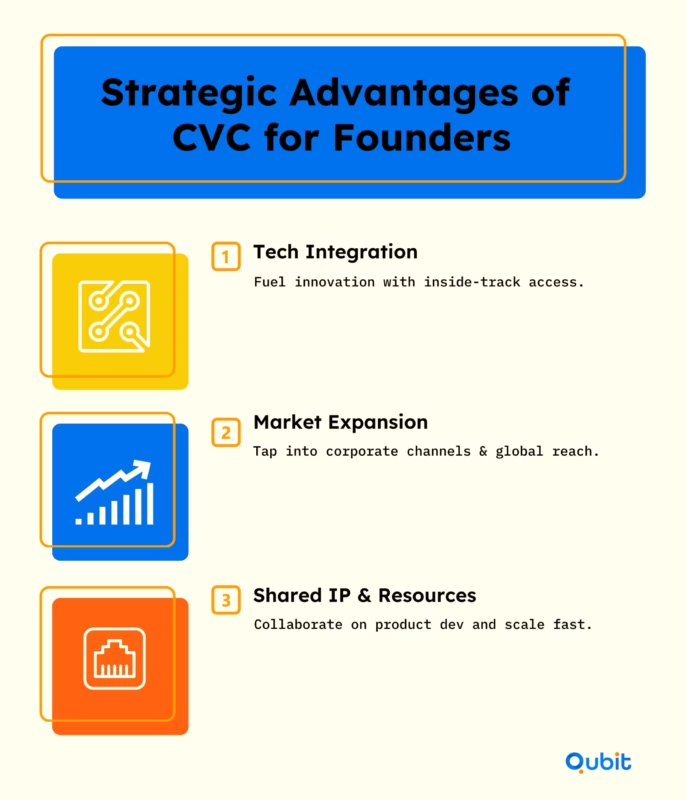Roughly 63% of corporate venture capital (CVC) deals go to early-stage startups. That’s not just money—it’s a signal that big companies are placing serious bets on young, unproven ideas.
This blog breaks down what corporate venture capital means for founders. You’ll learn how it differs from traditional VC, where strategic partnerships come into play, and why some startups benefit from more than just a check.
To see how this model compares with other capital sources, the breakdown of types of startup funding offers helpful context before diving in.
We’ll explore benefits, trade-offs, and the signals CVC partners look for. Let’s jump right in.
Your Go-To Hub for Branding and Resources
Corporate venture capital (CVC) thrives on collaboration, innovation, and access to the right tools. This section serves as a dynamic placeholder for branding and promotional activities tailored to partnerships. It highlights essential external resources that provide scholarly and industry insights, supporting deeper discussions on CVC strategies.
For academic perspectives, the Higher Ed portal by Harvard Business Publishing is an invaluable resource. It offers access to scholarly publications that define information critical to understanding corporate venture capital. Additionally, the Trademark Policy outlines legal guidelines for referencing proprietary content, ensuring compliance in branding efforts.
How to Align Strategy and Financial Returns in CVC
While the primary goal of CVC is to drive innovation and growth for the parent company, achieving this without compromising profitability is a challenge that requires careful planning and execution.
Strategic Alignment: The Foundation of CVC Success
Aligning CVC initiatives with the parent company’s core strategy is essential. Experts highlight that corporate venture funds are increasingly narrowing their focus on startups that complement their organizational goals. This approach ensures that investments not only yield financial returns but also contribute to long-term business growth. For instance, a case study revealed how a company integrated an acquired startup into its operations as a 100% owned subsidiary. Using an innovation garage model, the startup accelerated new business development, showcasing the strategic benefits of CVC investments.
Financial Returns: Balancing Risk and Reward
CVC investments come with inherent risks, as evidenced by the 80% failure rate associated with such ventures. Despite these challenges, corporate interest in early-stage startups remains strong, with CVC-backed funding reaching $55.1 billion in 2023. Although this figure reflects a 46% year-over-year decrease, it underscores the sustained commitment of corporations to innovation. To mitigate risks, companies often adopt a five-year investment horizon, allowing sufficient time for ventures to mature and deliver measurable outcomes.
Metrics That Matter
Tracking the right metrics is crucial for balancing strategy and financial returns. Key indicators include the alignment of ventures with corporate goals, the maturity timeline of investments, and the overall success rate of funded startups. These metrics help organizations refine their approach and maximize the impact of their CVC programs.
While CVC offers capital plus strategic backing, not every founder wants outside influence. The contrast is clear when you look at bootstrapping strategies for startups, where growth is driven by internal momentum and retained control.
By focusing on ventures that align with strategic priorities and adopting a long-term view, companies can optimize their CVC efforts to deliver both innovation and profitability.
How Venture Capital Helps You Define Strategic Priorities
Venture capital plays a pivotal role in shaping the trajectory of high-growth, early-stage companies. By providing essential funding, traditional venture capital (VC) enables startups to scale rapidly while balancing significant risk with the potential for substantial rewards. This approach is driven by a singular focus: maximizing financial returns for investors.
Corporate venture capital (CVC), however, introduces a nuanced perspective. Unlike traditional VC, CVC blends financial objectives with strategic corporate benefits. Companies engaging in CVC often aim to align investments with their broader business goals, such as fostering innovation, accessing emerging technologies, or strengthening industry partnerships. This dual focus allows corporations to not only profit from their investments but also gain insights that directly support their strategic priorities.
Understanding how different funding models complement or compete with corporate ventures is essential.
Ultimately, venture capital—whether traditional or corporate—serves as a critical tool for defining and refining strategic priorities. While traditional VC prioritizes financial returns, CVC offers a unique blend of profit and strategic alignment, enabling companies to achieve both growth and innovation.
Discover How CVC Drives Synergies and Expands Markets
It’s not just about funding startups—it’s about fueling innovation that feeds back into the business.
- Focuses on strategic synergies like tech integration and new market access, not just financial returns.
- Helps corporations invest in startups that align with long-term goals, creating mutual growth opportunities.
- Cemex’s CVC arm, for example, targets sustainable building and digital construction startups to reinforce its core business.
- CVC often includes partnerships involving product access, distribution channels, or shared IP—not just capital.
- These collaborations help startups scale while giving corporates an inside track on innovation.
- Offers insights into market trends and emerging technologies, helping companies stay adaptable and competitive.
- For companies like Cemex, it’s a way to expand their edge while staying rooted in strategic priorities.

CVC deals often go beyond capital. They work best when tied to product access, distribution, or shared IP—making strategic partnerships for startup funding a key part of the bigger picture. These partnerships often serve as catalysts for innovation, enabling startups to scale while providing corporations with access to cutting-edge solutions.
How Corporate Venture Capital Operates Behind the Scenes
Corporate venture capital (CVC) thrives on a collaborative ecosystem, bringing together industry partners, innovative startups, and seasoned investors to drive growth and innovation. This operational framework is designed to foster synergy while distributing risk, enabling corporations to explore emerging technologies and business models with agility.
The Backbone of CVC: Investment Committees and Governance Structures
At the heart of CVC operations lies a structured approach, anchored by investment committees and governance frameworks. These entities ensure that every decision aligns with the strategic goals of the parent corporation. Investment committees evaluate potential startups, assessing their scalability, market fit, and alignment with corporate objectives. Meanwhile, governance structures provide oversight, ensuring transparency and mitigating risks associated with high-stakes investments.
Strategic collaboration points further enhance this process. Corporations often work closely with startups to refine product offerings, test solutions, and accelerate market entry. This agile approach allows companies to adopt innovations quickly, minimizing risk while maximizing potential returns. For example, the Rapid Adoption trend highlights how parent corporations can test and integrate new technologies efficiently, fostering innovation without jeopardizing existing operations.
Industry Partners and Built Professionals: A Collaborative Network
CVC initiatives rely heavily on partnerships with industry experts and built professionals. These collaborators bring specialized knowledge and resources to the table, enabling startups to scale effectively. By pooling expertise, corporations and startups can navigate complex challenges, from regulatory compliance to market expansion, ensuring mutual success.
For early-stage companies exploring alternative funding avenues, microloans for startups offer a compelling comparison. These smaller-scale financing options provide flexibility and accessibility, complementing the larger-scale investments typically associated with CVC.
Agile Adoption Trends in CVC
The rapid expansion of CVC reflects a growing emphasis on agility and innovation. Corporations are increasingly embracing structured processes that allow them to test solutions quickly, adapt to market changes, and foster long-term growth. This trend underscores the importance of balancing risk mitigation with the pursuit of groundbreaking ideas, ensuring that both startups and corporations benefit from the partnership.
By understanding the operational intricacies of CVC, businesses can unlock new opportunities for innovation and growth, paving the way for transformative industry advancements.
How to Maximize Innovation and Value Through Strategy
Corporate venture capital (CVC) programs are designed to achieve more than financial returns. They aim to redefine how businesses approach sustainability, innovation, and customer-centric strategies. By focusing on strategic improvements, CVC initiatives often prioritize alignment with the parent company’s broader mission over pure ROI considerations.
Driving Sustainability and Innovation
One of the primary objectives of CVC programs is fostering sustainability and innovation. These initiatives enable companies to explore cutting-edge technologies and solutions that address environmental challenges while maintaining profitability. For example, investing in startups that develop renewable energy solutions or eco-friendly products can simultaneously enhance a company’s market position and contribute to global sustainability goals.
Enhancing Customer Centricity
CVC programs also emphasize customer-centric strategies by identifying startups that align with evolving consumer needs. This approach ensures that the parent company remains competitive in dynamic markets. By integrating innovative solutions from startups, businesses can refine their offerings to deliver greater value to their customers.
Strategic Over ROI
Unlike traditional investment models, CVC programs often prioritize strategic benefits over immediate financial returns. This focus allows companies to invest in ventures that complement their long-term vision, such as improving health and safety standards or driving EBITDA growth. CVC offers strategic alignment, but not every startup fits that mold. The broader landscape in alternative funding for startups shows how flexible capital can come from less structured, founder-first models.
CVC programs are not just about financial gains; they are about creating a roadmap for sustainable growth and innovation. By aligning investments with the parent company’s mission, these initiatives ensure that every venture contributes to a larger strategic purpose.
Conclusion
A clear, narrative-driven approach to corporate venture capital can transform how startups secure funding and achieve growth. By aligning strategic objectives with financial goals, businesses can ensure their investments not only fuel innovation but also drive measurable outcomes. The strategies discussed throughout this article emphasize the importance of storytelling, goal alignment, and adaptability in the ever-evolving startup ecosystem.
At Qubit Capital, we understand the challenges startups face in securing strategic capital. We invite you to explore our Fundraising Assistance service to connect with the resources and expertise needed to propel your venture forward.
Key Takeaways
- CVC investments provide strategic partnerships that extend beyond mere capital infusion.
- Startups benefit from access to industry expertise and accelerated market expansion.
- The high risks associated with CVC require careful alignment with corporate strategy.
- Real-world examples, such as Cemex Ventures, highlight the effective blending of innovation with operational integration.
- Incorporating diverse funding sources—including CVC—can optimize growth trajectories.
Frequently asked Questions
What is corporate venture capital?
Corporate venture capital refers to investments made by large companies in early-stage startups aimed at fostering innovation and driving long-term strategic growth.


 Back
Back



